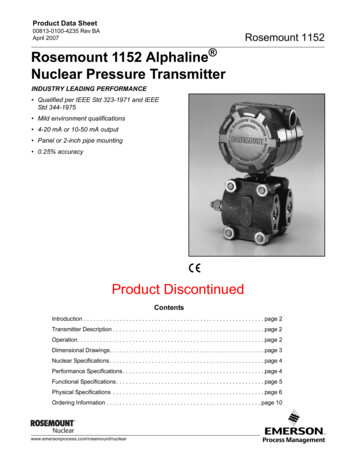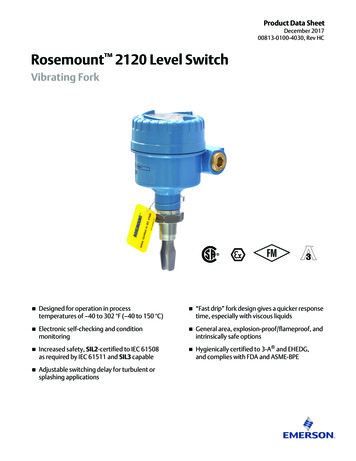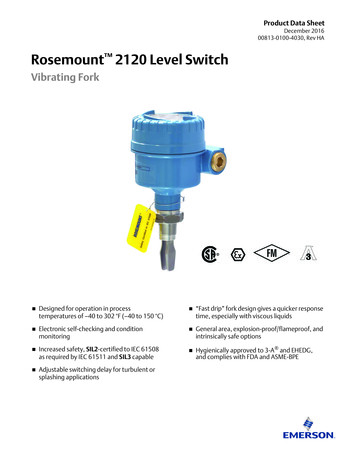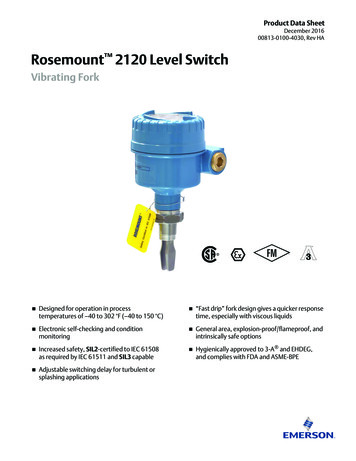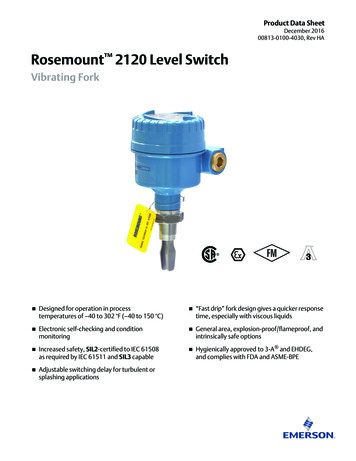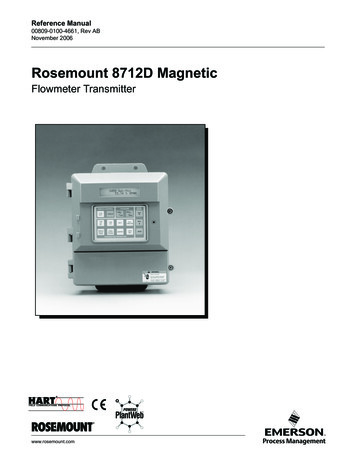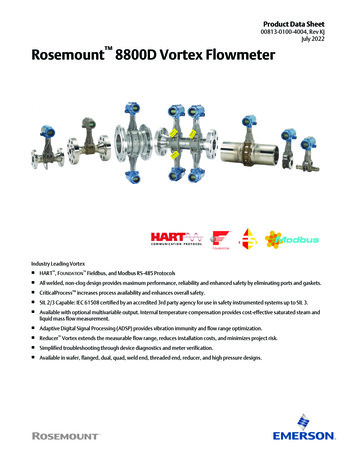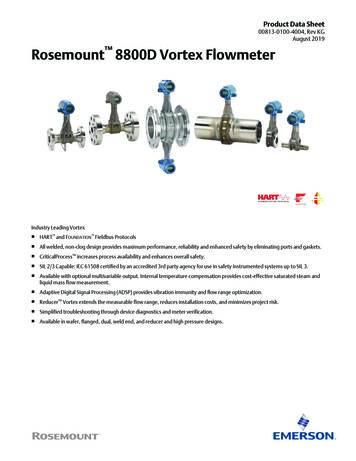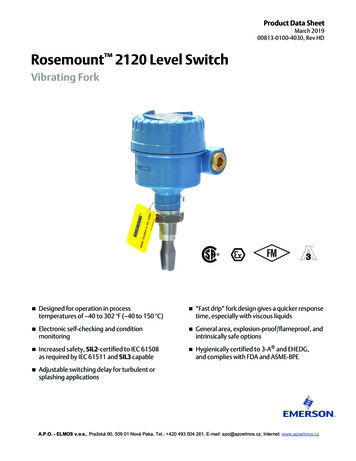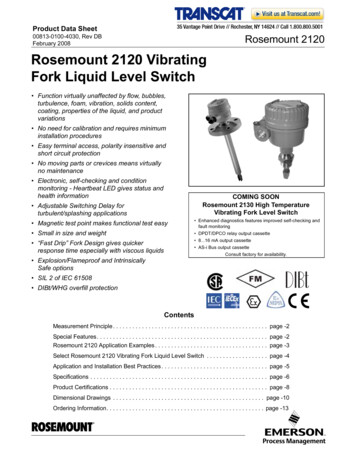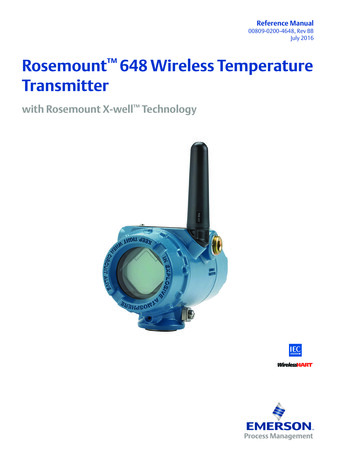
Transcription
Reference Manual00809-0200-4648, Rev BBJuly 2016Rosemount 648 Wireless TemperatureTransmitterwith Rosemount X-well Technology
Title PageReference ManualJuly 201600809-0200-4648, Rev BBRosemount 648 WirelessTemperature TransmitterRosemount 648 Wireless Hardware RevisionHART Device RevisionDevice Install Kit/DD Revision14Device Revision 4, DD Revision 1 or higherNOTICERead this manual before working with the product. For personal and system safety, andfor optimum product performance, make sure to thoroughly understand the contentsbefore installing, using, or maintaining this product.For technical assistance. contacts are listed below:Customer CentralTechnical support, quoting, and order related questions.United States:1-800-999-9307 (7:00 a.m. to 7:00 p.m. CST)Asia Pacific:65 777 8211Europe/ Middle East/ Africa:49 (8153) 9390North American Response CenterEquipment service needs1-800-654-7768 (24 hours - includes Canada)Outside of these areas, contact your local Emerson Process Managementrepresentative.The products described in this document are NOT designed for nuclear-qualifiedapplications.Using non-nuclear qualified products in applications that require nuclear-qualifiedhardware or products may cause inaccurate readings.For information on Rosemount nuclear-qualified products, contact a Emerson ProcessManagement Sales Representative.Title Pageiii
Reference ManualTitle Page00809-0200-4648, Rev BBJuly 2016Failure to follow these installation guidelines could result in death or seriousinjury.Make sure only qualified personnel perform the installation.Explosions could result in death or serious injury. Installation of this transmitter in an explosive environment must be in accordance withthe appropriate local, national, and international standards, codes, and practices.Review the approvals section of the Rosemount 648 Wireless Reference Manual for anyrestrictions associated with a safe installation.Before connecting a Field Communicator in an explosive atmosphere, ensure theinstruments are installed in accordance with intrinsically safe or non-incendivefield wiring practices.Process leaks may cause harm or result in death. Install and tighten process connectors before applying pressure.Electrical shock can result in death or serious injury. Avoid contact with the leads and terminals. High voltage that may be present onleads can cause electrical shock.This device complies with Part 15 of the FCC Rules. Operation is subject to thefollowing conditions: ivThis device may not cause harmful interference.This device must accept any interference received, including interference that maycause undesired operation.This device must be installed to ensure a minimum antenna separation distance of20 cm from all persons.The power module may be replaced in a hazardous area. The power module hassurface resistivity greater than one gigaohm and must be properly installed in thewireless device enclosure. Care must be taken during transportation to and fromthe point of installation to prevent electrostatic charge build-up.Title Page
Reference Manual00809-0200-4648, Rev BBTitle PageJuly 2016NOTICEThe Rosemount 648 Wireless and all other wireless devices should be installed onlyafter the Smart Wireless Gateway has been installed and is functioning properly.Wireless devices should also be powered up in order of proximity from the SmartWireless Gateway, beginning with the closest. This will result in a simpler and fasternetwork installation.Shipping considerations for wireless products (lithium batteries: Black PowerModule, model number 701PBKKF):The unit was shipped to you without the power module installed. Remove the powermodule prior to shipping the unit.Each Black Power Module contains two “C” size primary lithium-thionyl chloridebattery. Primary lithium batteries are regulated in transportation by the U. S.Department of Transportation, and are also covered by IATA (International AirTransport Association), ICAO (International Civil Aviation Organization), and ARD(European Ground Transportation of Dangerous Goods). It is the responsibility of theshipper to ensure compliance with these or any other local requirements. Consultcurrent regulations and requirements before shipping.Power Module Considerations (Black Power Module, model number 701PBKKF):The Black Power Module with the wireless unit contains two “C” size primarylithium-thionyl chloride battery (model number 701PGNKF). Each battery containsapproximately 2.5 grams of lithium, for a total of 5 grams in each pack. Under normalconditions, the battery materials are self-contained and are not reactive as long as thebatteries and the pack integrity are maintained. Care should be taken to preventthermal, electrical or mechanical damage. Contacts should be protected to preventpremature discharge.Battery hazards remain when cells are discharged.Power modules should be stored in a clean and dry area. For maximum power modulelife, storage temperature should not exceed 30 C.Title Pagev
Title PageJuly 2016viReference Manual00809-0200-4648, Rev BBTitle Page
Reference ManualContents00809-0200-4648, Rev BBJuly 2016Contents1Section 1: Introduction1.1 Using this manual . . . . . . . . . . . . . . . . . . . . . . . . . . . . . . . . . . . . . . . . . . . . . . . . . . . . . . . . . . . . . . . . . 11.2 Product recycling/disposal. . . . . . . . . . . . . . . . . . . . . . . . . . . . . . . . . . . . . . . . . . . . . . . . . . . . . . . . . . 12Section 2: Configuration2.1 Overview . . . . . . . . . . . . . . . . . . . . . . . . . . . . . . . . . . . . . . . . . . . . . . . . . . . . . . . . . . . . . . . . . . . . . . . . . 32.2 Safety messages. . . . . . . . . . . . . . . . . . . . . . . . . . . . . . . . . . . . . . . . . . . . . . . . . . . . . . . . . . . . . . . . . . . 32.3 Sensor connections . . . . . . . . . . . . . . . . . . . . . . . . . . . . . . . . . . . . . . . . . . . . . . . . . . . . . . . . . . . . . . . . 42.3.1 Thermocouple or millivolts inputs . . . . . . . . . . . . . . . . . . . . . . . . . . . . . . . . . . . . . . . . . . . . . 42.3.2 RTD or ohm inputs . . . . . . . . . . . . . . . . . . . . . . . . . . . . . . . . . . . . . . . . . . . . . . . . . . . . . . . . . . . 42.4 Bench top configuration. . . . . . . . . . . . . . . . . . . . . . . . . . . . . . . . . . . . . . . . . . . . . . . . . . . . . . . . . . . . 82.4.1 Field Communicator . . . . . . . . . . . . . . . . . . . . . . . . . . . . . . . . . . . . . . . . . . . . . . . . . . . . . . . . . 92.4.2 AMS Device Manager and AMS Wireless Configurator . . . . . . . . . . . . . . . . . . . . . . . . . . . . 92.4.3 Smart Wireless Gateway . . . . . . . . . . . . . . . . . . . . . . . . . . . . . . . . . . . . . . . . . . . . . . . . . . . . . 102.4.4 Default settings . . . . . . . . . . . . . . . . . . . . . . . . . . . . . . . . . . . . . . . . . . . . . . . . . . . . . . . . . . . . 102.4.5 Device sensor configuration. . . . . . . . . . . . . . . . . . . . . . . . . . . . . . . . . . . . . . . . . . . . . . . . . . 102.5 HART menu tree. . . . . . . . . . . . . . . . . . . . . . . . . . . . . . . . . . . . . . . . . . . . . . . . . . . . . . . . . . . . . . . . . . 112.6 Basic setup . . . . . . . . . . . . . . . . . . . . . . . . . . . . . . . . . . . . . . . . . . . . . . . . . . . . . . . . . . . . . . . . . . . . . . 142.6.1 Configure sensor type . . . . . . . . . . . . . . . . . . . . . . . . . . . . . . . . . . . . . . . . . . . . . . . . . . . . . . . 142.6.2 Join device to network . . . . . . . . . . . . . . . . . . . . . . . . . . . . . . . . . . . . . . . . . . . . . . . . . . . . . . . 142.6.3 Configure update rate . . . . . . . . . . . . . . . . . . . . . . . . . . . . . . . . . . . . . . . . . . . . . . . . . . . . . . . 152.7 Fast Key sequence . . . . . . . . . . . . . . . . . . . . . . . . . . . . . . . . . . . . . . . . . . . . . . . . . . . . . . . . . . . . . . . . 172.8 Calibration. . . . . . . . . . . . . . . . . . . . . . . . . . . . . . . . . . . . . . . . . . . . . . . . . . . . . . . . . . . . . . . . . . . . . . . 172.8.1 Sensor input trim . . . . . . . . . . . . . . . . . . . . . . . . . . . . . . . . . . . . . . . . . . . . . . . . . . . . . . . . . . . 182.8.2 Transmitter-sensor matching . . . . . . . . . . . . . . . . . . . . . . . . . . . . . . . . . . . . . . . . . . . . . . . . 192.9 Advanced setup . . . . . . . . . . . . . . . . . . . . . . . . . . . . . . . . . . . . . . . . . . . . . . . . . . . . . . . . . . . . . . . . . . 202.9.1 LCD display . . . . . . . . . . . . . . . . . . . . . . . . . . . . . . . . . . . . . . . . . . . . . . . . . . . . . . . . . . . . . . . . 202.9.2 Rosemount X-well technology. . . . . . . . . . . . . . . . . . . . . . . . . . . . . . . . . . . . . . . . . . . . . . . . 222.9.3 Process Alerts . . . . . . . . . . . . . . . . . . . . . . . . . . . . . . . . . . . . . . . . . . . . . . . . . . . . . . . . . . . . . . 242.10 Remove power module . . . . . . . . . . . . . . . . . . . . . . . . . . . . . . . . . . . . . . . . . . . . . . . . . . . . . . . . . . . 253Section 3: Installation3.1 Overview . . . . . . . . . . . . . . . . . . . . . . . . . . . . . . . . . . . . . . . . . . . . . . . . . . . . . . . . . . . . . . . . . . . . . . . . 273.2 Safety messages. . . . . . . . . . . . . . . . . . . . . . . . . . . . . . . . . . . . . . . . . . . . . . . . . . . . . . . . . . . . . . . . . . 273.3 Wireless considerations . . . . . . . . . . . . . . . . . . . . . . . . . . . . . . . . . . . . . . . . . . . . . . . . . . . . . . . . . . . 28Contents1
Reference ManualContents00809-0200-4648, Rev BBJuly 20163.3.1 Power up sequence . . . . . . . . . . . . . . . . . . . . . . . . . . . . . . . . . . . . . . . . . . . . . . . . . . . . . . . . . 283.3.2 Antenna position . . . . . . . . . . . . . . . . . . . . . . . . . . . . . . . . . . . . . . . . . . . . . . . . . . . . . . . . . . . 283.3.3 Conduit entry . . . . . . . . . . . . . . . . . . . . . . . . . . . . . . . . . . . . . . . . . . . . . . . . . . . . . . . . . . . . . . 293.4 Field Communicator connections. . . . . . . . . . . . . . . . . . . . . . . . . . . . . . . . . . . . . . . . . . . . . . . . . . . 293.5 Physical Installation . . . . . . . . . . . . . . . . . . . . . . . . . . . . . . . . . . . . . . . . . . . . . . . . . . . . . . . . . . . . . . . 303.5.1 Direct mount . . . . . . . . . . . . . . . . . . . . . . . . . . . . . . . . . . . . . . . . . . . . . . . . . . . . . . . . . . . . . . . 313.5.2 Remote mount . . . . . . . . . . . . . . . . . . . . . . . . . . . . . . . . . . . . . . . . . . . . . . . . . . . . . . . . . . . . . 323.6 Rosemount X-well Installation . . . . . . . . . . . . . . . . . . . . . . . . . . . . . . . . . . . . . . . . . . . . . . . . . . . . 343.7 LCD display . . . . . . . . . . . . . . . . . . . . . . . . . . . . . . . . . . . . . . . . . . . . . . . . . . . . . . . . . . . . . . . . . . . . . . 343.8 Ground the transmitter . . . . . . . . . . . . . . . . . . . . . . . . . . . . . . . . . . . . . . . . . . . . . . . . . . . . . . . . . . . 354Section 4: Commissioning4.1 Overview . . . . . . . . . . . . . . . . . . . . . . . . . . . . . . . . . . . . . . . . . . . . . . . . . . . . . . . . . . . . . . . . . . . . . . . . 374.2 Safety messages. . . . . . . . . . . . . . . . . . . . . . . . . . . . . . . . . . . . . . . . . . . . . . . . . . . . . . . . . . . . . . . . . . 374.3 Verify operation . . . . . . . . . . . . . . . . . . . . . . . . . . . . . . . . . . . . . . . . . . . . . . . . . . . . . . . . . . . . . . . . . . 384.3.1 LCD display . . . . . . . . . . . . . . . . . . . . . . . . . . . . . . . . . . . . . . . . . . . . . . . . . . . . . . . . . . . . . . . . 384.3.2 Field Communicator . . . . . . . . . . . . . . . . . . . . . . . . . . . . . . . . . . . . . . . . . . . . . . . . . . . . . . . . 394.3.3 Smart Wireless Gateway . . . . . . . . . . . . . . . . . . . . . . . . . . . . . . . . . . . . . . . . . . . . . . . . . . . . . 404.3.4 AMS Wireless Configurator . . . . . . . . . . . . . . . . . . . . . . . . . . . . . . . . . . . . . . . . . . . . . . . . . . 405Section 5: Operation and Maintenance5.1 LCD display screen messages . . . . . . . . . . . . . . . . . . . . . . . . . . . . . . . . . . . . . . . . . . . . . . . . . . . . . . 435.1.1 Startup screen sequence. . . . . . . . . . . . . . . . . . . . . . . . . . . . . . . . . . . . . . . . . . . . . . . . . . . . . 435.1.2 Diagnostic button screen sequence . . . . . . . . . . . . . . . . . . . . . . . . . . . . . . . . . . . . . . . . . . . 455.1.3 Network diagnostic status screens . . . . . . . . . . . . . . . . . . . . . . . . . . . . . . . . . . . . . . . . . . . . 465.1.4 Device diagnostic screens. . . . . . . . . . . . . . . . . . . . . . . . . . . . . . . . . . . . . . . . . . . . . . . . . . . . 485.2 Power module replacement . . . . . . . . . . . . . . . . . . . . . . . . . . . . . . . . . . . . . . . . . . . . . . . . . . . . . . . 516Section 6: Troubleshooting6.1 Overview . . . . . . . . . . . . . . . . . . . . . . . . . . . . . . . . . . . . . . . . . . . . . . . . . . . . . . . . . . . . . . . . . . . . . . . . 53AAppendix A: Specifications and Reference DataA.1 Specifications . . . . . . . . . . . . . . . . . . . . . . . . . . . . . . . . . . . . . . . . . . . . . . . . . . . . . . . . . . . . . . . . . . . . 57A.1.1 Functional specifications. . . . . . . . . . . . . . . . . . . . . . . . . . . . . . . . . . . . . . . . . . . . . . . . . . . . . 57A.1.2 Physical specifications . . . . . . . . . . . . . . . . . . . . . . . . . . . . . . . . . . . . . . . . . . . . . . . . . . . . . . . 57A.1.3 Performance specifications . . . . . . . . . . . . . . . . . . . . . . . . . . . . . . . . . . . . . . . . . . . . . . . . . . 58A.1.4 Accuracy. . . . . . . . . . . . . . . . . . . . . . . . . . . . . . . . . . . . . . . . . . . . . . . . . . . . . . . . . . . . . . . . . . . 59A.1.5 Ambient temperature effect . . . . . . . . . . . . . . . . . . . . . . . . . . . . . . . . . . . . . . . . . . . . . . . . . 602Contents
Reference ManualContents00809-0200-4648, Rev BBJuly 2016A.1.6 Process temperature effects . . . . . . . . . . . . . . . . . . . . . . . . . . . . . . . . . . . . . . . . . . . . . . . . . 61A.1.7 Examples of approximate lead wire resistance effect calculations . . . . . . . . . . . . . . . . . 62A.2 Dimensional drawings . . . . . . . . . . . . . . . . . . . . . . . . . . . . . . . . . . . . . . . . . . . . . . . . . . . . . . . . . . . . 63BAppendix B: Product CertificationsB.1 European Directive Information . . . . . . . . . . . . . . . . . . . . . . . . . . . . . . . . . . . . . . . . . . . . . . . . . . . . 69B.2 Telecommunication Compliance . . . . . . . . . . . . . . . . . . . . . . . . . . . . . . . . . . . . . . . . . . . . . . . . . . . 69B.2.1 FCC and IC . . . . . . . . . . . . . . . . . . . . . . . . . . . . . . . . . . . . . . . . . . . . . . . . . . . . . . . . . . . . . . . . . 69B.3 Ordinary Location Certification . . . . . . . . . . . . . . . . . . . . . . . . . . . . . . . . . . . . . . . . . . . . . . . . . . . . . 69B.4 Installing in North America. . . . . . . . . . . . . . . . . . . . . . . . . . . . . . . . . . . . . . . . . . . . . . . . . . . . . . . . . 69B.5 Installation drawing. . . . . . . . . . . . . . . . . . . . . . . . . . . . . . . . . . . . . . . . . . . . . . . . . . . . . . . . . . . . . . . 73CAppendix C: Mapping for Non-DD Based Integration with HostSystemsC.1 Alert message mapping . . . . . . . . . . . . . . . . . . . . . . . . . . . . . . . . . . . . . . . . . . . . . . . . . . . . . . . . . . . 75C.2 Mapping of device variables index numbers. . . . . . . . . . . . . . . . . . . . . . . . . . . . . . . . . . . . . . . . . . 77Contents3
ContentsJuly 20164Reference Manual00809-0200-4648, Rev BBContents
IntroductionReference ManualJuly 201600809-0200-4648, Rev BBSection 11.1IntroductionUsing this manualThe sections in this manual provide information on installing, operating, and maintaining theRosemount 648 Wireless Temperature Transmitter with WirelessHART protocol. The sectionsare organized as follows:Section 2: Configuration provides instruction on commissioning and operating Rosemount 648Wireless. Information on software functions, configuration parameters, and online variables isalso included.Section 3: Installation contains mechanical and electrical installation instructions.Section 4: Commissioning contains techniques for properly commissioning the device.Section 5: Operation and Maintenance contains operation and maintenance techniques.Section 6: Troubleshooting contains troubleshooting tips as well as information to contacttechnical support over the phone or through email.Appendix A: Specifications and Reference Data supplies reference and specification data, as wellas ordering information.Appendix B: Product Certifications contains approval information.Appendix C: Mapping for Non-DD Based Integration with Host Systems contains importantalerts in the HART command 48 additional status field for the Rosemount 648 Wireless.1.2Product recycling/disposalRecycling of equipment and packaging should be taken into consideration and disposed of inaccordance with local and national legislation/regulations.Introduction1
IntroductionJuly 20162Reference Manual00809-0200-4648, Rev BBIntroduction
Reference ManualConfiguration00809-0200-4648, Rev BBJuly 2016Section 2ConfigurationOverview . . . . . . . . . . . . . . . . . . . . . . . . . . . . . . . . . . . . . . . . . . . . . . . . . . . . . . . . . . . . . . . .Safety messages . . . . . . . . . . . . . . . . . . . . . . . . . . . . . . . . . . . . . . . . . . . . . . . . . . . . . . . . . .Sensor connections . . . . . . . . . . . . . . . . . . . . . . . . . . . . . . . . . . . . . . . . . . . . . . . . . . . . . . .Bench top configuration . . . . . . . . . . . . . . . . . . . . . . . . . . . . . . . . . . . . . . . . . . . . . . . . . . .Basic setup . . . . . . . . . . . . . . . . . . . . . . . . . . . . . . . . . . . . . . . . . . . . . . . . . . . . . . . . . . . . . . .Remove power module . . . . . . . . . . . . . . . . . . . . . . . . . . . . . . . . . . . . . . . . . . . . . . . . . . . .2.1page 3page 3page 4page 8page 14page 25OverviewThis section contains information on configuration and verification that should beperformed prior to installation. Field Communicator and AMS Device Managerinstructions are given to perform configuration functions. For convenience, FieldCommunicator Fast Key sequences are labeled “Fast Keys” for each software function belowthe appropriate headings.Sensor input trim exampleFast Keys sequence2.21, 2, 3, etc.Safety messagesInstructions and procedures in this section may require special precautions to ensure thesafety of the personnel performing the operations. Information that potentially raises safetyissues is indicated by a warning symbol ( ). Refer to the following safety messages beforeperforming an operation preceded by this symbol.Failure to follow these installation guidelines could result in death or seriousinjury. Make sure only qualified personnel perform the installation.Explosions could result in death or serious injury.Installation of this transmitter in an explosive environment must be in accordance withthe appropriate local, national, and international standards, codes, and practices.Review the approvals section of the Rosemount 648 Wireless TemperatureTransmitter Reference Manual for any restrictions associated with a safe installation.Before connecting a Field Communicator in an explosive atmosphere, ensure theinstruments are installed in accordance with intrinsically safe or non-incendivefield wiring practices.Process leaks may cause harm or result in death. ConfigurationInstall and tighten process connectors before applying pressure.3
Reference ManualConfiguration00809-0200-4648, Rev BBJuly 2016Electrical shock can result in death or serious injury.Avoid contact with the leads and terminals. High voltage that may be present onleads can cause electrical shock.This device complies with Part 15 of the FCC Rules. Operation is subject to thefollowing conditions: This device may not cause harmful interference.This device must accept any interference received, including interference thatmay cause undesired operation. This device must be installed to ensure a minimum antenna separation distanceof 20 cm from all persons.The power module may be replaced in a hazardous area. The power module has surfaceresistivity greater than one gigaohm and must be properly installed in the wirelessdevice enclosure. Care must be taken during transportation to and from the point ofinstallation to prevent electrostatic charge build-up. 2.3Sensor connectionsThe Rosemount 648 Wireless is compatible with a number of RTD and thermocouple sensortypes. Figure 2-1 shows the correct input connections to the sensor terminals on thetransmitter. To ensure a proper sensor connection, anchor the sensor lead wires into theappropriate compression terminals and tighten the screws.Make sensor connections through the cable entry in the side of the connection head. Besure to provide adequate clearance for cover removal.When using Rosemount X-well Technology, the Rosemount 648 Wireless is required to beassembled to a Rosemount 0085 Pipe Clamp RTD Sensor in a direct mount 3-wireconfiguration.2.3.1Thermocouple or millivolts inputsThe thermocouple can be connected directly to the transmitter. Use appropriatethermocouple extension wire if mounting the transmitter remotely from the sensor.2.3.2RTD or ohm inputsThe Rosemount 648 Wireless will accept a variety of RTD or ohmic configurations, including2-, 3-, or 4-wire connections. If the Rosemount 648 Wireless is mounted remotely using a 3or 4-wire connection, it will operate withing specifications without recalibration for leadwire resistances of up to 5 ohms per lead (equivalent to 500 ft. of 20 AWG wire). In this case,the leads between the RTD and transmitter is recommended to be shielded.If using a 2-wire connection, both RTD leads are in series with the sensor element. This cancause significant errors if the lead lengths exceed 3 ft. of 20 AWG wire (approximately0.05 C/ft.). For longer runs, it is recommended to attach a third or fourth lead to achievethe benefits of a 3- or 4-wire connection as described above.4Configuration
Reference ManualConfiguration00809-0200-4648, Rev BBJuly 2016Sensor lead wire resistance effect—RTD inputSince the lead wires are part of the RTD circuit, the lead wire resistance needs to becompensated for to achieve the best accuracy. This becomes especially critical inapplications where long sensor and/or lead wires are used. There are three lead wireconfigurations commonly available.A 4-wire design is ideal because the lead wire resistance is inconsequential to themeasurement. It uses a measurement technique where a very small constant current ofabout 150 micro amps is applied to the sensor through two leads and the voltagedeveloped across the sensor is measured over the other two wires with a high-impedanceand high resolution measuring circuit. In accordance with Ohm's Law, the high impedancevirtually eliminates any current flow in the voltage measurement leads and therefore theresistance of the leads is not a factor.In a 3-wire configuration, compensation is accomplished using the third wire with theassumption that it will be the same resistance as the other two wires and the samecompensation is applied to all three wires.In a 2-wire configuration there can be no compensation for lead wire resistance since thelead wires are in series with the element and appear to the transmitter as part of the sensor'sresistance causing inherent accuracy degradation.Table 2-1. Examples of Approximate Basic ErrorConfigurationSensor inputApproximate basic error4-wire RTDNegligible(1)3-wire RTDError in reading is equivalent to unbalanced lead wire resistance(2)2-wire RTDError in reading equivalent total lead wire resistance1.Independent of lead wire resistance up to 5 per lead.2.Unbalanced lead wire resistance is the maximum resistance differences between any of two leads.5
Reference ManualConfiguration00809-0200-4648, Rev BBJuly 2016Figure 2-1. Sensor WiringThermocouple/mV4 Wire RTD and 3 Wire RTD and 2 Wire RTD and Figure 2-2. Rosemount 648 Wireless Sensor Connections12342-wire RTD and 12343-wire RTD and 12344-wire RTD and 1234T/C and mVNote: Emerson Process Management provides 4-wire sensors for all single element RTDs. Use these RTDs in 3-wireconfigurations by leaving the unneeded leads disconnected and insulated with electrical tape.6Configuration
Reference ManualConfiguration00809-0200-4648, Rev BBJuly 2016Lead wire configurationFigure 2-3. Rosemount 68Q, 78 Standard Temperature Range, and 58C RTD SensorSingle elementWhite (1)White (2)Red (3)Red (4)Figure 2-4. Rosemount 65, 78 High Temp, 68 RTDSingle elementWhite (1)White (2)Red (3)Red (4)Figure 2-5. Rosemount 183 ThermocoupleType J White (2) Purple (2)– Red (3)– Red (3)Type KConfigurationType EType T Yellow (2) Blue (2)– Red (3)– Red (3)7
Reference ManualConfiguration00809-0200-4648, Rev BBJuly 2016Figure 2-6. Rosemount 185 ThermocoupleType JType N Black (2) Pink (2)– White (3)– White (3)Type K Green (2)–White (3)NoteWire color examples apply to Rosemount sensors, but will vary by manufacturer.Sensor leadsIf the sensor is installed in a high-voltage environment and a fault condition or installationerror occurs, the sensor leads and transmitter terminals could carry lethal voltages. Useextreme caution when making contact with the leads and terminals.Use the following steps to wire the sensor and supply power to the transmitter:2.41.Remove the transmitter enclosure cover (if applicable).2.Attach the sensor leads according to the wiring diagrams.3.Connect the power module.4.Verify the connection by observing the LCD display (if applicable).5.Reattach and tighten the cover (if applicable).Bench top configurationBench top configuration consists of testing the transmitter and verifying transmitterconfiguration data. The Rosemount 648 Wireless must be configured before installation,which may be performed either directly or remotely. Direct configuration can be performedusing a Field Communicator, AMS Device Manager, AMS Wireless Configurator, or anyWirelessHART Communicator. Remote configuration can be performed using AMS DeviceManager, AMS Wireless Configurator, or the Smart Wireless Gateway.The power module must be installed to provide power to the Rosemount 648 Wireless forconfiguration. To communicate to the transmitter, begin by removing the powermodule-side housing cover, indicated as “Field terminals” by text located on the side of thedevice. This will expose the terminal block and HART Communication terminals, which arelabeled “COMM”. Connect the power module to supply power for configuration. SeeFigure 2-7.8Configuration
Reference ManualConfiguration00809-0200-4648, Rev BBJuly 2016Figure 2-7. Connection Diagram for Rosemount 648 Wireless and Field Communicator12P/N 00753-9200-0020342.4.1COMMField CommunicatorWhen performing device configuration directly, connect the bench equipment as shown inFigure 2-7 above, and turn on the field communicator by pressing the ON/OFF key. Whenusing a Field Communicator, any configuration changes must be sent to the transmitter byusing the Send key (F2).The Field Communicator will search for a HART-compatible device and indicate when theconnection is made. If the Field Communicator fails to connect, it will indicate that nodevice was found. If this occurs. refer to Section 6: Troubleshooting.NoteFor HART Wireless transmitter communication via a Field Communicator, a Rosemount 648Wireless Device Dashboard (DD) is required. Rosemount 648 Wireless Transmittersequipped with Rosemount X-well Technology requires DD revision 648 Dev. 4 Rev. 1 orhigher to view Rosemount X-well functionality. To obtain the latest DD, visit the 475 FieldCommunicator System Software and Device Description site at:EmersonProcess.com/Field-Communicator2.4.2AMS Device Manager and AMS Wireless ConfiguratorWhen configuring the Rosemount 648 Wireless using AMS Device Manager or AMS WirelessConfigurator, double click the Rosemount 648 Wireless device icon (or right click and selectConfigure/Setup), then select the Configure/Setup tab. AMS Device Managerconfiguration changes are implemented when the Apply button is selected.NoteFor HART Wireless transmitter communication via AMS, a Rosemount 648 Wireless DeviceDashboard (DD) is required. Rosemount 648 Wireless Transmitters equipped withRosemount X-well Technology requires DD revision 648 Dev. 4 Rev. 1 or higher to viewRosemount X-well functionality. To obtain the latest DD, visit the Emerson ProcessManagement. Easy Upgrade site tion9
Reference ManualConfiguration00809-0200-4648, Rev BBJuly 20162.4.3Smart Wireless GatewayThe Rosemount 648 Wireless supports limited remote configuration through the SmartWireless Gateway. The Gateway allows configuration of the following device parameters:HART Tag, Short Tag, Descriptor, Engineering Units, Update Rate and Range Values.2.4.4Default settingsThe Rosemount 648 Wireless default configuration is shown below:Sensor typePt 100 ( 0.00385)Engineering units CNumber of lead wires4Network IDFactory generated network parametersJoin KeyFactory generated network parametersUpdate Rate1 minuteNoteThe C1 option code can be used to enable factory configuration of the Update Rate, Date,Descriptor and Message fields. This code is not required to have the factory configure theSensor Type, Connection or the Self Organizing Network parameters.2.4.5Device sensor configurationEvery temperature sensor has unique characteristics. In order to ensure the most accurateme
The Rosemount 648 Wireless and all other wireless devices should be installed only after the Smart Wireless Gateway has been installed and is functioning properly. Wireless devices should also be powered up in order of proximity from the Smart Wireless Gateway, beginning with the closest. This will result in a simpler and faster network .
